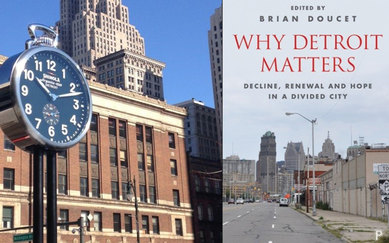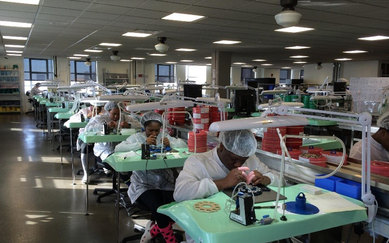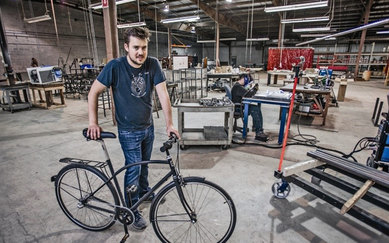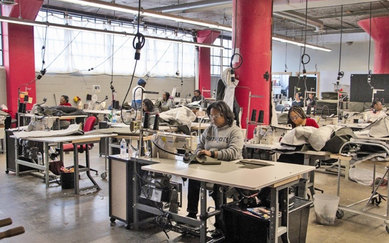Why Detroit Matters, Part 3: Made in Detroit: Detroit’s New Industrial Economy
Detroit’s ongoing recovery efforts have led to a wide range of unique and innovative planning and design responses. For the Why Detroit Matters blog series (parts one and two), SmithGroup’s David Lantz sat down with Urban Design Practice Director Dan Kinkead to discuss the chapter Dan wrote for the recently published book Why Detroit Matters: Decline, Renewal and Hope in a Divided City. Dan focuses on Detroit’s emerging and precedent-setting approaches to urban redevelopment and recovery, and their growing significance at a national and international level.
This post considers the new models of industrial development being constructed in post-industrial Detroit.
DL: With urban recovery efforts there’s always a big emphasis on job creation. You wrote about the reindustrialization that’s happening within the city in your chapter. People frequently talk about the post-industrial economy, but you explore the idea of a new industrial economy for Detroit, and the city’s ability to build off its unique skeleton of abandoned manufacturing infrastructure.
DK: Right.
DL: How big of an advantage has that been for Detroit to move some of these new industrial enterprises forward?
DK: I think simply having the expansive industrial infrastructure here—facilities that range in size from the very large former auto factories to smaller second and third-tier supplier spaces—is substantial. From facilities to logistics networks, there’s just a lot to choose from. Perhaps too many options, but that old infrastructure remains available for people to utilize.
At the same time there’s also a remarkable workforce here: a trained, skilled labor force that can adapt from one method of manufacturing to another.
The other key ingredient has to do with Detroit’s previous industrial revolution, where its long-term gain was tied to a Fordist model of mass production and, consequently, mass consumption. The fallacy of that model being sustainable has come to yield a sometimes cataclysmic and breathtaking understanding that the models moving forward need to be much more nuanced. They need to be centered around innovation and flexibility to meet market need as it emerges and more importantly, to diversify the products that are put out.
This is where Detroit’s industrial complex can be repositioned for a range of uses and impacts. Shinola positioned its entire brand around Detroit’s recovery, and the street credibility this provides in any market. When they do that, they’re looking to recapture the authenticity and supremacy, to a certain degree, of the manufacturing process here and what it means to make things in Detroit. However, they do it in a way that actually creates jobs in Detroit for Detroiters, training folks to make the watches here and to create an endemic workforce. The approach is unique and has been pretty transformative.
At the same time, we see how a city that was dominated by the auto industry of the past can draw on its former employees for new industry. A company like Detroit Bikes, which has set up shop here in one of the second-tier type spaces, is realizing opportunities to employ the very Detroiters who once were on the line while also utilizing, in some cases, the very equipment that had also been on the line. You see this kind of full revolution of the skill set and the equipment back into a new type of industry.
Ponyride is another dimension of Detroit’s reindustrialization: one that is much more granular and nuanced, while also being committed to larger social and economic objectives. Ponyride helps people to start up their own businesses—helping them incubate and to create the networks that can support them.
Ponyride is one of the earliest—and remains one of the best—examples of this incubator approach, but many more are emerging each day. In these cases, Detroit’s formidable philanthropic center comes into play. For many of these philanthropies, their corpus, their endowments, were made on the former auto industry and either its mass production or mass consumption economy. Those endowments are now present to support some of these key social enterprises, and to support groups like Ponyride and other related economic programs.
DL: As a business incubator, Ponyride has been tremendously successful. What’s kind of interesting—and you can see it in Shinola and Detroit Bikes as well as the big names that have come out of Ponyride, including Detroit Denim and The Empowerment Plan—is whether it’s watches, bikes, or clothing, there’s an almost pre-industrial, hand-crafted emphasis to the new manufacturing that’s emerging.
For example, take Detroit Bikes. Very few bikes are being manufactured in the U.S. at this point, so a lot of the frames and component pieces they use are imported from elsewhere. It’s no different than industry in many other places, but “made in Detroit” often means “assembled in Detroit,” doesn’t it?
DK: Yes, that’s right. In some ways it’s indicative of the fact that the previous models of vertical integration are gone, where all the components would be in a raw state harvested here, transformed here, re-appropriated and then assembled here. Because of the broader shifts in the economy and the resulting change in the global logistics network, now you can get a lot more of these things shipped around on demand in a way that you couldn’t in the past. I think Detroit has definitely leveraged that to its benefit while still providing jobs to probably a smaller number of people, but in a more flexible and durable way that can move through some of these up-and-down economic cycles.
It’s not part of the mass production, vertical integration model of industry that we’ve seen previously. It’s also, I think, a new methodology around manufacturing that is not necessarily just a boutique brand concept, but is definitely scaled to meet market demand in an array of smaller markets. For example, there isn’t a race to dominate the entire bike market driving Detroit Bikes, but a commitment to producing them here, supplying them here, and identifying other potential markets—like their contract with New Belgium Brewing Company. But it’s not intended to be everywhere.
It’s a more nuanced or measured approach to market share and volume here, with a keen eye on creating business models that are sustainable.
Dan Kinkead, AIA, is SmithGroupJJR’s Urban Design National Practice Director and a Principal at the firm.



